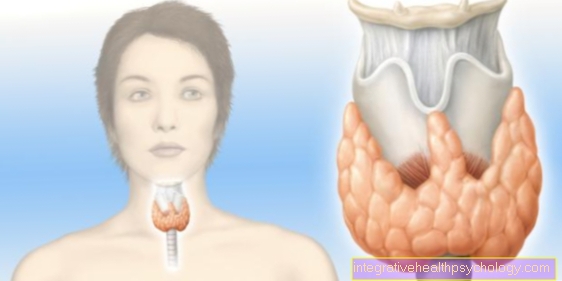How long is a cold contagious?
introduction
The common cold affects almost everyone at least once a year and is particularly common in the cold months. The term common cold suggests that the cold has something to do with the cold, but the low temperatures do not trigger the disease. With a cold, a pathogen is transmitted and spread. In most cases these are typical cold viruses, of which there are many different. More rarely, bacteria can also cause the common cold. In these cases, the disease is often more persistent and accompanied by other symptoms. Your own infection and that of others depend on various factors. The pathogens can find their way into the environment in many ways and lead to colds, earaches, sore throats, pneumonia, sinus infections and other diseases via various transmission routes.

How long is a cold contagious?
An uncomplicated cold, triggered by typical pathogens, lasts about 9-10 days if left untreated. The disease runs in phases. Affected people are potentially contagious in each of these phases, even 1st-2nd. Days before the onset of symptoms in the so-called incubation phase, when contact with the cold viruses or bacteria has already taken place, but their number is not yet large enough to trigger the disease.
In principle, it can be said that the risk of infection goes hand in hand with the development of the symptoms of the disease. Since the symptoms are rather minor or barely noticeable during the incubation phase, the risk of infection is not very high, but neglected hygiene measures, such as kissing or not washing your hands frequently, often lead to infection. After all, the person concerned does not yet know that they carry a pathogen in their body and that they are transmitted by touching objects or through physical contact.
After the incubation phase, when the pathogens have successfully multiplied and lodged in the body and in the mucous membranes, they achieve the onset of the typical cold symptoms in the initial phase of the cold. The initial phase of the common cold lasts about 1-2 days and is characterized by the onset of typical symptoms such as runny nose, fever, as well as sore throat and body aches, as the pathogens are now present in sufficient quantities. The acute phase of the disease with the maximum number of pathogens follows on the 3rd - 5th day of the cold. As a result, the risk of infection is greatest in this phase!
After the first contact with the pathogen, the immune system gets to know it and begins with a so-called "immune response" to the germs. After a few days, antibodies are formed that fight the germs. Since the immune response can only set in with a delay after a short preparation time, the pathogen can still spread unhindered in the acute phase. Often the immune system only gains the upper hand over the pathogens in the late phase on the 6-9 day of the disease and fights them with the antibodies formed, so that after a few days the symptoms subside and shortly afterwards all pathogens are eliminated. From the 10th day of illness, the symptoms should have subsided. If you feel really fit and alert again, the risk of infection is rather low. Nevertheless, it is advisable not to take any risks so as not to harm yourself and not to endanger others through infection.
The exact timing of these processes can vary with the nature of the pathogen or the immune system. Different pathogens can multiply at different speeds, be more aggressive or resistant, and penetrate the mucous membranes more easily or more difficultly and therefore cause infections even with a lower number of pathogens. On the other hand there is the immune system, which can be weakened by previous illnesses, the influence of medication or stress. A lowered immune system can hardly ward off infection, especially in old age and childhood. Overall, these factors influence the duration of the disease and the severity of its phases, which can vary depending on the patient.
Also read:
- Course of a cold
- Incubation period with a cold
- When do I have to see a doctor with a cold?
Are you already contagious during the incubation period?
The incubation period describes the period from infection and initial contact with the pathogen to the appearance of the first symptoms such as sore throat, runny nose or fever. The incubation period for typical cold viruses is around 2-3 days. If the immune system is weak, this period is even shorter. During this time, the germs attach themselves to the mucous membranes and multiply until the first symptoms set in. During the incubation period, patients are potentially contagious!
However, the risk of infection is less dependent on the number of germs in the body, which is still rather low, but much more on neglected hygiene measures, as the person concerned does not yet know anything about their disease. Particularly due to poor hand hygiene or kissing during the incubation period, the likelihood of infection can be almost as high as in the symptomatic phase of the common cold, in which the risk of infection is associated with a high number of germs in the body.
Can you get infected by kissing?
Kissing increases the likelihood of infection. When kissing on the mouth, there is direct contact between the oral mucous membranes of two people, which is why the transmission of droplets with pathogens is significantly increased. The intensity of the kiss can have an impact on the likelihood of transmission. Particularly intense kisses involve more pathogen exchange than a quick kiss on the cheek.
A disease that is similar to a cold is Pfeiffer's glandular fever. This is also known as "kissing disease", as it is very often transmitted in adolescence by kissing someone who is already infected with the virus. Basically, kissing a person with an acute cold increases the risk of an illness, but does not guarantee it. Here, too, a healthy immune system, a weak pathogen and other favorable factors are still decisive for whether there is an infection.
What is the typical route of infection?
The typical way to get infected is through droplet infection. When you have a cold, the viruses mainly accumulate on the mucous membranes of the nose, mouth and throat. Even when breathing, tiny, often invisible droplets are expelled that carry a certain amount of the virus. Accordingly, larger amounts of the pathogen are expelled into the air through sneezing, spitting and coughing. These can be distributed in the room air and settle on the mucous membranes of people in the immediate vicinity. The small infectious droplets can also settle on objects or hands and are transported and spread. The hands are the most important source of germs. The small droplets can be spread in particular via keyboards, telephones, doorknobs and other objects that are increasingly touched. Since most people touch their faces for almost a minute, the pathogens quickly reach the mucous membranes via the nose or mouth.
Also read: How can you prevent a cold?
What can be done to prevent others from being infected?
The most important measure to prevent the common cold from spreading is hygiene. Hygiene includes being careful in public to prevent one's own infection, as well as being considerate towards others in the event of one's own illness. Since the hands are the most important route of infection, hand hygiene must be guaranteed. For this purpose, intensive hand washing with warm water and soap but also disinfectants can be used. To protect others, you should also ensure that your hands are clean during your own illness before touching doorknobs or remote controls. Accumulations of pathogens, for example from used cutlery and glasses or used handkerchiefs, should be eliminated quickly and independently. Clothes and bedclothes should also be washed at regular intervals, as droplets containing pathogens also collect there.
You may also be interested in this topic:
- Therapy for a cold
- Home remedies for a cold
Does the risk of infection differ between viral and bacterial pathogens?
Viruses and bacteria differ fundamentally from one another in terms of their nature, reproduction, infection, type of illness and duration of illness. However, both can trigger the typical colds with only slightly different symptoms. There is a risk of infection for both types of pathogens and since the pathogens also differ greatly within viruses and bacteria, no increased risk can be stated for a specific type. Overall, the classic, often seasonal colds are mostly caused by viruses. They are aggressive and spread very quickly, but are cured just as quickly. Bacterial colds are less common, but can be much more persistent and can sometimes only be cured with antibiotic treatments.
More on this: The viral cold
Is a cat cold contagious to humans?
A cold in a cat is a very acute and serious illness for the animal. As a person, however, you can take care of the cat without hesitation, as the common cold cannot be transmitted from the cat to the person. Humans can only be one factor in the development of cat flu. Through their clothing, humans can carry pathogens that are dangerous for cats into the house and that can infect cats. However, there is only a risk of infection for other cats.
Is a dog cold contagious to humans?
Even with dogs, there is no reason to fear infection. The animals are mainly infected with other dogs, and contact with people is largely harmless. Dogs generally suffer from diseases from a different spectrum of pathogens that humans are usually not able to harm. However, it is possible that individual viruses rarely overlap. In general, nothing stands in the way of cuddling with a cold dog, as the infection between the races is extremely rare.





























